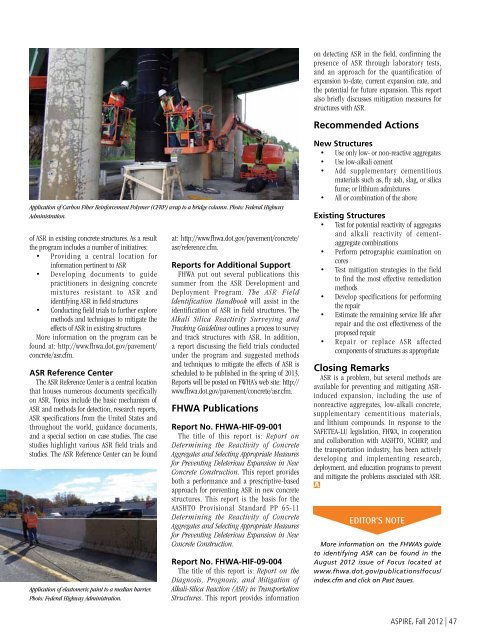ASPIRE Fall 2012 - Aspire - The Concrete Bridge Magazine
ASPIRE Fall 2012 - Aspire - The Concrete Bridge Magazine
ASPIRE Fall 2012 - Aspire - The Concrete Bridge Magazine
Create successful ePaper yourself
Turn your PDF publications into a flip-book with our unique Google optimized e-Paper software.
on detecting ASR in the field, confirming the<br />
presence of ASR through laboratory tests,<br />
and an approach for the quantification of<br />
expansion to-date, current expansion rate, and<br />
the potential for future expansion. This report<br />
also briefly discusses mitigation measures for<br />
structures with ASR.<br />
Recommended Actions<br />
Application of Carbon Fiber Reinforcement Polymer (CFRP) wrap to a bridge column. Photo: Federal Highway<br />
Administration.<br />
of ASR in existing concrete structures. As a result<br />
the program includes a number of initiatives:<br />
• Providing a central location for<br />
information pertinent to ASR<br />
• Developing documents to guide<br />
practitioners in designing concrete<br />
mixtures resistant to ASR and<br />
identifying ASR in field structures<br />
• Conducting field trials to further explore<br />
methods and techniques to mitigate the<br />
effects of ASR in existing structures<br />
More information on the program can be<br />
found at: http://www.fhwa.dot.gov/pavement/<br />
concrete/asr.cfm.<br />
ASR Reference Center<br />
<strong>The</strong> ASR Reference Center is a central location<br />
that houses numerous documents specifically<br />
on ASR. Topics include the basic mechanism of<br />
ASR and methods for detection, research reports,<br />
ASR specifications from the United States and<br />
throughout the world, guidance documents,<br />
and a special section on case studies. <strong>The</strong> case<br />
studies highlight various ASR field trials and<br />
studies. <strong>The</strong> ASR Reference Center can be found<br />
Application of elastomeric paint to a median barrier.<br />
Photo: Federal Highway Administration.<br />
at: http://www.fhwa.dot.gov/pavement/concrete/<br />
asr/reference.cfm.<br />
Reports for Additional Support<br />
FHWA put out several publications this<br />
summer from the ASR Development and<br />
Deployment Program. <strong>The</strong> ASR Field<br />
Identification Handbook will assist in the<br />
identification of ASR in field structures. <strong>The</strong><br />
Alkali Silica Reactivity Surveying and<br />
Tracking Guidelines outlines a process to survey<br />
and track structures with ASR. In addition,<br />
a report discussing the field trials conducted<br />
under the program and suggested methods<br />
and techniques to mitigate the effects of ASR is<br />
scheduled to be published in the spring of 2013.<br />
Reports will be posted on FWHA’s web site: http://<br />
www.fhwa.dot.gov/pavement/concrete/asr.cfm.<br />
FHWA Publications<br />
Report No. FHWA-HIF-09-001<br />
<strong>The</strong> title of this report is: Report on<br />
Determining the Reactivity of <strong>Concrete</strong><br />
Aggregates and Selecting Appropriate Measures<br />
for Preventing Deleterious Expansion in New<br />
<strong>Concrete</strong> Construction. This report provides<br />
both a performance and a prescriptive-based<br />
approach for preventing ASR in new concrete<br />
structures. This report is the basis for the<br />
AASHTO Provisional Standard PP 65-11<br />
Determining the Reactivity of <strong>Concrete</strong><br />
Aggregates and Selecting Appropriate Measures<br />
for Preventing Deleterious Expansion in New<br />
<strong>Concrete</strong> Construction.<br />
Report No. FHWA-HIF-09-004<br />
<strong>The</strong> title of this report is: Report on the<br />
Diagnosis, Prognosis, and Mitigation of<br />
Alkali-Silica Reaction (ASR) in Transportation<br />
Structures. This report provides information<br />
New Structures<br />
• Use only low- or non-reactive aggregates<br />
• Use low-alkali cement<br />
• Add supplementary cementitious<br />
materials such as, fly ash, slag, or silica<br />
fume; or lithium admixtures<br />
• All or combination of the above<br />
Existing Structures<br />
• Test for potential reactivity of aggregates<br />
and alkali reactivity of cementaggregate<br />
combinations<br />
• Perform petrographic examination on<br />
cores<br />
• Test mitigation strategies in the field<br />
to find the most effective remediation<br />
methods<br />
• Develop specifications for performing<br />
the repair<br />
• Estimate the remaining service life after<br />
repair and the cost effectiveness of the<br />
proposed repair<br />
• Repair or replace ASR affected<br />
components of structures as appropriate<br />
Closing Remarks<br />
ASR is a problem, but several methods are<br />
available for preventing and mitigating ASRinduced<br />
expansion, including the use of<br />
nonreactive aggregates, low-alkali concrete,<br />
supplementary cementitious materials,<br />
and lithium compounds. In response to the<br />
SAFETEA-LU legislation, FHWA, in cooperation<br />
and collaboration with AASHTO, NCHRP, and<br />
the transportation industry, has been actively<br />
developing and implementing research,<br />
deployment, and education programs to prevent<br />
and mitigate the problems associated with ASR.<br />
Editor’s Note<br />
More information on the FHWA’s guide<br />
to identifying ASR can be found in the<br />
August <strong>2012</strong> issue of Focus located at<br />
www.fhwa.dot.gov/publications/focus/<br />
index.cfm and click on Past Issues.<br />
<strong>ASPIRE</strong>, <strong>Fall</strong> <strong>2012</strong> | 47

















